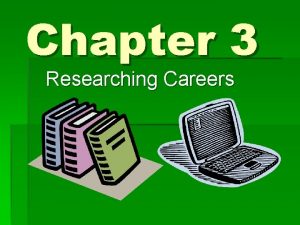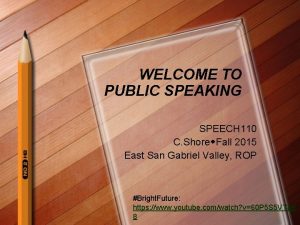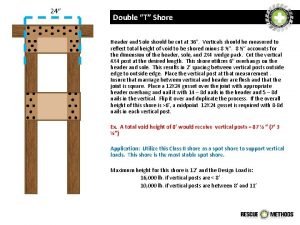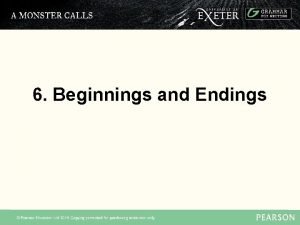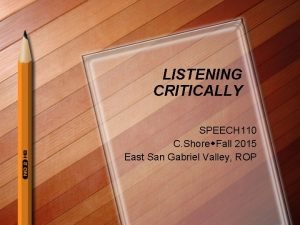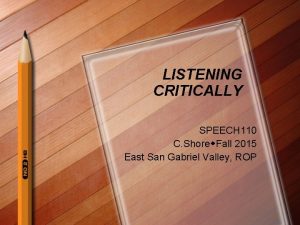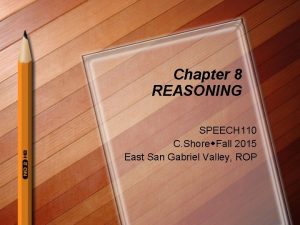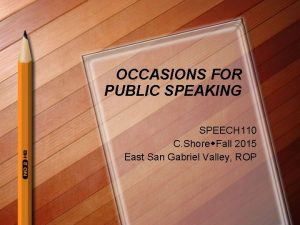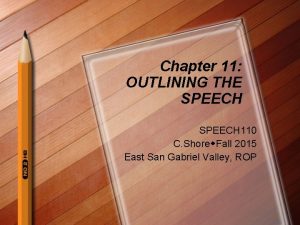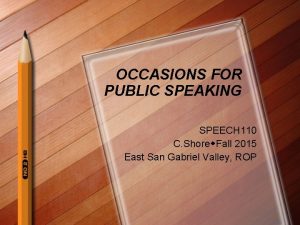RESEARCHING THE SPEECH 110 C Shore Fall 2015















- Slides: 15

RESEARCHING THE SPEECH 110 C. Shore Fall 2015 East San Gabriel Valley, ROP 1

Learning Objectives l l l l 7. 1: Make strategic choices about research in light of your audience and your purpose. 7. 2: Identify types of material that are available to support the ideas in your speech. 7. 3: Use tools to locate supporting materials for your speech. 7. 4: Describe several categories of sources you can use as supporting materials and when you might use each. 7. 5: Explain the factors that can cause evidence to be deficient and the strategic questions you can use to evaluate Internet evidence. 7. 6: Conduct research efficiently and productively. 7. 7: Explain and use guidelines for how to cite sources and how to take notes about your research. 2

7. 1: Strategic Perspectives on Research l Three basic goals: 1. 2. 3. l To develop or strengthen your own expertise on the topic To find the evidence that will support your ideas To make your ideas coherent, obvious, understandable, and pertinent to your audience Research Choices: – – How much general background reading to do What issues will require supporting material What types of supporting material is required How much supporting material is required 3

7. 2: Types of Supporting Material l l Personal experience Common knowledge l – Primary evidence – Strong support l – “Social knowledge” l l Statistics – Simple enumeration – Surveys and polls – Rates of change – Experiments Direct observation Examples – Brief examples – Hypothetical examples – Anecdotes – Case Studies Documents l Testimony – Factual – Opinion 4

7. 3: Tools for Locating Supporting Material l l Search engines Electronic databases Catalogs Indexes – Newspaper – Periodical – Government http: //ballotpedia. org/California_elections, _2015 5

7. 3: Tools for Locating Supporting Material 6

7. 4: Sources of Supporting Material l Periodicals – General-interest – Specific-interest – Technical l l Newspapers Books Reference works Government publications Other materials found online l Interviews – Prepare for the person – Prepare for the subject – Prepare for the format l Open v. Closed ended questions – Conduct the interview competently – Take notes or record interview – Determine main points 7

Researching Your Topic Types of Info 1. Testimony (expert vs. lay) 2. 3. 4. 5. Scholarship/statis tics Anecdotes Quotes Compare + contrast Eval. Source 1. Credible 2. Up-to-Date 3. Accurate 4. Relevant 5. Reliable CRAAP test -> http: //www. gettysbu rg. edu/library/resear ch/tips/webeval/

7. 5: Evaluating Evidence l Potential Deficiencies in Evidence – Unavailable for inspection – Inaccurate or uncertain – Not credible – Not from expert – Inconsistent – Contradicted – Outdated – Irrelevant 9

7. 5: Evaluating Evidence l The Quality of Internet Evidence – Is the site credible? – Who set up the website? – What are the source’s credentials? – What is the purpose? – Does the content reflect scholarship? – Can you confirm the info? – When was the website updated? 10

7. 6: A Plan for Research l l l Start early Determine where you’re going Bring materials Learn library layout Develop preliminary bibliography 11

7. 6: A Plan for Research l l l Organize bibliography Read critically Use multiple sources Avoid plagiarism Keep a speech file Know when to stop 12

7. 7: Note Taking • • • Use a flexible system Include bibliographic citations Quote or paraphrase sources Properly cite quotations Take notes only once APA Reference list -> https: //owl. english. purdue. edu/owl/r esource/560/05/ 13

Take Away l 7. 1: Make strategic choices about research in light of your audience and your purpose. – 3 basic goals – 5 strategic choices to consider while researching l 7. 2: Identify types of material that are available to support the ideas in your speech. – Personal experiences, common knowledge, direct observation, examples, documents, stats, experiments l l 7. 3: Use tools to locate supporting materials for your speech. 7. 4: Describe several categories of sources you can use as supporting materials and when you might use each. – Academic journals, books, . edu’s/. gov’s 14

Take Away l 7. 5: Explain the factors that can cause evidence to be deficient and the strategic questions you can use to evaluate Internet evidence. – Currency, Relevance, Authority, Accuracy, Purpose l 7. 6: Conduct research efficiently and productively. – Start with an outline, make a reference list l 7. 7: Explain and use guidelines for how to cite sources and how to take notes about your research. – Use the APA reference list: https: //owl. english. purdue. edu/owl/resource/560/05/ 15




